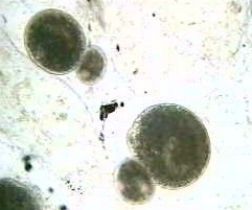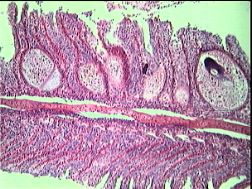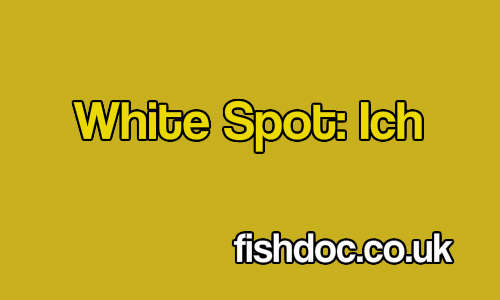A common but lethal disease
The ciliated parasite Ichthyophthirius, more commonly known as white spot or Ich, is a very common fish disease capable of affecting virtually all fish species. Ich has a fairly complex life cycle that has a major bearing on treatment methods. The white spot trophont (photo below) forms a nodule under the skin or gill epithelium.
The trophont constantly turns and moves under the skin, feeding on destroyed cells and body fluids. The parasite feeds on body cells until mature and then ‘punches’ its way out of the skin. It then attaches itself to a plant or some other object and forms a capsules around itself. Inside the capsule, the tomont, as it is now called, repeatedly divides, producing up to 1000 tomites that finally ‘hatch’ from the capsule and swim to find a fish host. These small tomites are the infective agent. They burrow into the fish’s skin and the cycle starts all over again. Clearly, with each turn of the cycle the number of parasites increases dramatically.
White spot |
|
 White spot trophonts seen in at low power wet mount of a skin scrape. Note the light horseshoe shaped nucleus and the variation in size White spot trophonts seen in at low power wet mount of a skin scrape. Note the light horseshoe shaped nucleus and the variation in size |
|
 Histological preparation of gill tissue with embedded trophonts. Note the distortion to the gill tissue and severe hyperplasia Histological preparation of gill tissue with embedded trophonts. Note the distortion to the gill tissue and severe hyperplasia |
|
|
photos Frank Prince-Iles |
|
Tissue damage
In large numbers the parasite can cause considerable tissue damage from both its feeding activity while under the epithelium and during the entry and exit from its host. The tissue damage caused, particularly to gill tissue, is a major threat to fish health and can be the site for secondary bacterial or fungal infections. A prime example is seen in the microphotograph above. The trophonts can be clearly seen in the gill tissue. Their irritating activity has caused severe hyperplasia (abnormal cell growth). This particular fish ended up with severe gill tissue erosion and bacterial infection. Altogether, around 30 koi in this pond died in this outbreak.
Identifying Ich
White spot cysts, each containing an active trophont, appear as small white nodules on the skin, gills and fins, giving the fish the appearance of having been dusted with salt. In a confirmatory skin scrape the trophonts appear as dark round objects slowly rolling around. The trophonts vary in size, up to 1mm and are considerably bigger than most fish parasites. Other features sometimes seen are a lighter, horseshoe shaped nucleus (seen in the top photo) and short cilia covering the entire body (seen in the movie clips).
In the early stages of the disease, fish are likely to flash and rub against objects because of the irritation. At a later, advanced stage they will become lethargic and spend most of their time sitting on the bottom.
My own experience is that Ich commonly affects koi – but in the early stages the characteristic white spots are very difficult to spot. They are probably there but not very noticeable. This is one reason why it is best to do a skin scrape when parasites are suspected – so that you know exactly what you are dealing with! Even finding one trophont warrants immediate treatment.
Treatment
It is only the free-swimming stage of the parasite that is susceptible to treatment; neither the trophonts under the epithelium or the tomont cysts can be killed. So any treatment plan has to be carried out over a period of time in order to kill the emerging parasites. This in turn depends on temperature. At 7oC the life cycle will take six weeks, whereas at 25oC it will be complete in a week.
- An alternative treatment is prolonged salt immersion at 1-2 ppt (parts per thousand), i.e. 1-2 grams per litre
- Water should be monitored during the treatment course in case there is any loss of filter activity.
- It is also believed that fish that survive an attack of Ich have an increased immunity against future attacks
Lurking in the background!
Ich is most often brought into the tank or pond on new fish or plants (not if they are quarantined!). However, it is also believed that some survivors of an Ich infection can become latent carriers, with the parasites forming a latent stage at protected sites such as the base of fins or the gills.
Subsequent stress or poor conditions can awaken white spot to re-infect either its host or other fish. This certainly seems to be the case with koi, when often small numbers of trophonts are often found alongside severe fluke, Trichodina or Costia infestations, even in ponds which have not had any new introductions.

